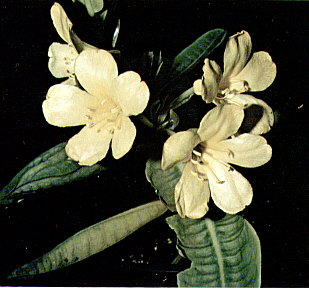QBARS - v28n4 Rhododendron intranervatum
Rhododendron intranervatum
J. Rouse, Victoria, Australia

|
|
R. intranervatum
Photo by J. Rouse |
In November 1973, one of my plants of
R. intranervatum
flowered in the glasshouse for the first time when about 30 cm. (1 foot) tall. It was grown from seed obtained from Great Britain in 1969 by Tom Lelliott. In Borneo,
R intranervatum
grows epiphytically, but this plant, shown in the photograph, is growing in a mixture of pelleted styrene foam and peat moss, 75:25 percent by volume, together with the usual nutrients.
This most striking rhododendron differs from others in the Vireya series through the leaves which are 15-20 cm. long, 5-10 cm. wide and with prominent ridges perpendicular to the midrib. They occur either opposite in pairs or singly and with an inter-node of 2-6 cm. The corollas are five-lobed, funnel-shaped opening to 3-4 cm. in diameter and a light yellow in color. To date, the flowers have come in threes or fours.
R. intranervatum
propagates readily from seed or cuttings and I expect it to be easily grafted onto hybrid Vireya stock. I prefer to grow Vireya Rhododendron in the garden or in a shade house and mostly they grow well outside since in winter the temperature seldom drops below more than 2° - 3°C of frost, and in summer although the temperature may climb to 40° - 42°C (about 108° F.), adequate shade or automatic occasional misting above 30°C (85° F.) is easily provided. However, the more epiphytic plants such as
R. jasminiflorum
or
R. arfakianum
grow more readily in the ground when grafted and I expect this will apply to
R. intranervatum
.
Comparing the flowers of
R. intranervatum
with other yellow flowering Vireya Rhododendrons, there is no doubt in my mind that the flowers of
R. laetum
and
R. aurigeranum
are a purer or more beautiful yellow and usually they have more flowers in the truss. However, both these rhododendrons suffer from long internodes of 10-20 cm. making the plants tall and straggly. I have crossed
R. intranervatum
with both these rhododendrons and hope to obtain among the hybrids, plants with shorter internodes than
R. laetum
or
R. aurigeranum
but with their glorious golden yellow flowers.
